
The Pieridae are a large family of butterflies with about 76 genera containing about 1,100 species, mostly from tropical Africa and tropical Asia with some varieties in the more northern regions of North America and Eurasia. Most pierid butterflies are white, yellow, or orange in coloration, often with black spots. The pigments that give the distinct coloring to these butterflies are derived from waste products in the body and are a characteristic of this family. The family was created by William John Swainson in 1820.

Anthocharis midea, the falcate orangetip, is a North American butterfly that was described in 1809 by Jacob Hübner. It belongs to the family Pieridae, which is the white and sulphurs. These butterflies are mostly seen in the eastern United States, and in Texas and Oklahoma. They eat the nectar of violets and mustards. They tend to live in open, wet woods along waterways, in open swamps, and less often in dry woods and ridgetops. This species is a true springtime butterfly, being on the wing from April to May.

Anthocharis cethura, the desert orangetip or Felder's orangetip, is a species of butterfly in the subfamily Pierinae. It is native to the southwestern United States and northern Mexico, where it lives on hills and ridges in rocky desert habitat.
Anthocharis cethura catalina, the Catalina orangetip, is a subspecies of the desert orangetip butterfly that is endemic to Santa Catalina Island, off the California coast of the United States. Very little is known about the subspecies, except that they tend to be found on isolated ridgetops.

Anthocharis sara, the Sara Orangetip is one of three species in the Sara Orangetip complex. It is a California endemic butterfly with populations extending from Baja California into extreme southwest Oregon. The common name, Pacific Orangetip, is obsolete since its implied distribution includes two separate species.

Anthocharis stella, the stella orangetip, is a species of butterfly found mainly in the Rocky Mountains in the United States where its caterpillar feeds on different kinds of rock cress. It has two subspecies.
Anthocharis stella browningi, the Utah Stella orangetip, is a subspecies of the Stella orangetip mainly found in the southern American Rocky Mountains especially in the drier areas.

Anthocharis thoosa, the southwestern orangetip, is a butterfly which has a range mainly from the American Rocky Mountains down into Mexico. It is a member of the Anthocharis sara complex.

The Pierinae are a large subfamily of pierid butterflies. The subfamily is one of several clades of butterflies often referred to as the whites.

The tribe Anthocharini is one of the subdivisions of the insect order Lepidoptera, which includes the moths and butterflies. It is a further subdivision of the butterfly family Pieridae and subfamily Pierinae; formerly it was considered a subfamily on its own, Anthocharinae. This tribe includes many, but not all, of the orangetip butterflies.

Anthocharis is a holarctic genus of the butterfly tribe Anthocharini, in the family Pieridae. These are typically small, white-hued butterflies that have colorful marks just inside the tips of the forewings. The tip colors are usually a red-orange hue, hence the name "orange tip". The larvae of these butterfly often consume cruciferous plants containing chemicals called glucosinolates. This genus is characterized by two of the five subcostal veins branching off before the apex of the cell, by the upper radial being only little united with the subcostal, and by the central discocellular being rather long. In all the species the males have at least the apical portion of the forewing orange red or yellow. Only one species inhabits also the northern districts of the Palearctic region, all the others are found in the south of the Palearctic region, also some species occur in North America, but not one species extends into the tropics. The Anthocharis species have only one brood. The butterflies occur in spring.

The hoary comma is a species of butterfly, common in boreal North America from Alaska, across southern Canada to New England and the Maritime Provinces and south to New Mexico from the Rocky Mountains to the Pacific Ocean. The wings have a distinctive ragged edge.

Chlosyne gorgone, the gorgone checkerspot, is a species of Nymphalinae butterfly that occurs in North America.
Orange tip or orangetip refers to:

Euphilotes ancilla, the Rocky Mountain dotted blue, is a species of butterfly of the family Lycaenidae. It is found from Washington south to California and southern Alberta and Saskatchewan south through the Rockies and high plains to Wyoming, Colorado, Utah, and northwestern New Mexico. The species was first described by William Barnes and James Halliday McDunnough in 1918.
Desert orange tip or desert orangetip may refer to the following butterflies:












